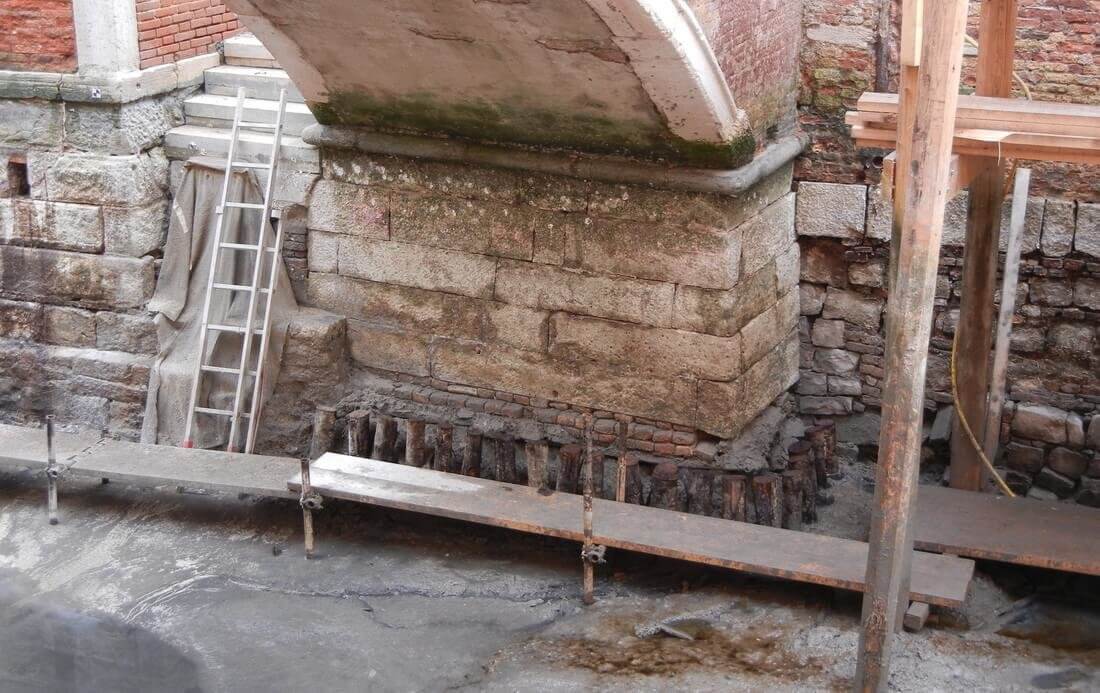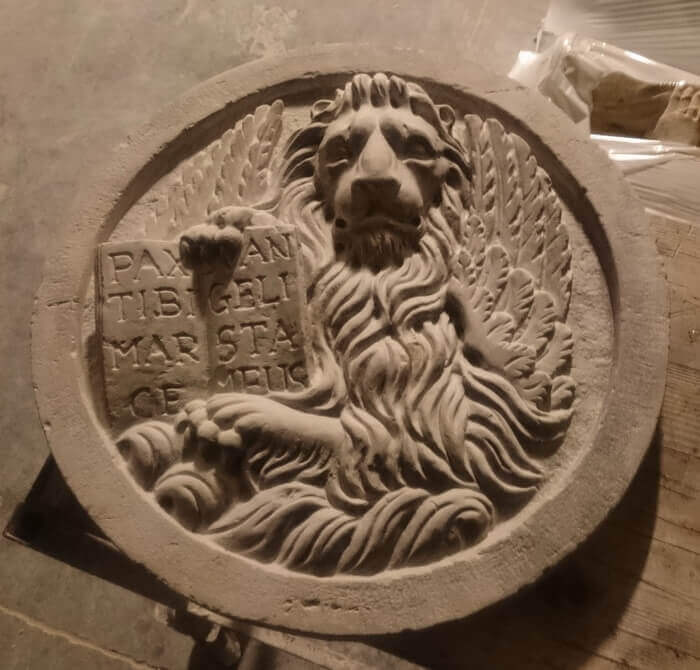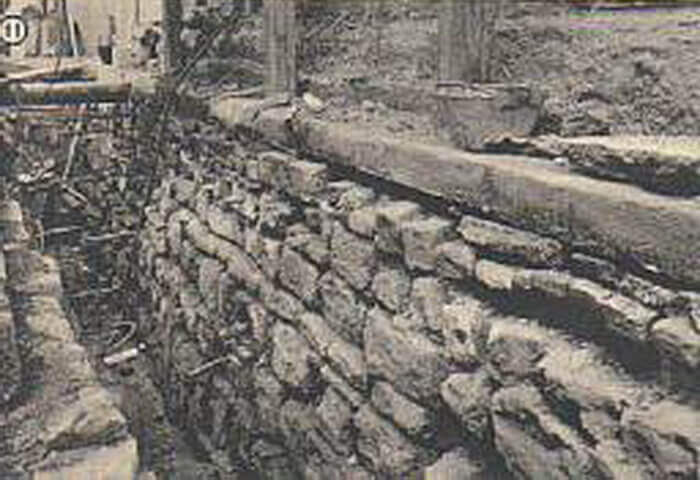
The Istrian stone marks the history and beauty of Venice
The fortune of Istrian stone is linked to the development of Venice during the Serenissima.
The Venetian Republic was a political and mercantile empire; it had an economy mainly based on maritime activities; the sea was considered the cheapest and fastest way of communication.
Why Venetians fall in love with the Istria stone
With the peace of Rialto in 933, the Duchy of Venice obtained from Istria, recognition of entitlement to freely sail and trade along the Istrian coast. Groups of Italians then moved to the western and some inland areas.
Until the 11th century, in the lagoon city, there were mainly wooden constructions; those in stone were a rarity.

Venice’s history: the foundations in wood and Istrian stone
With the conquest of the cities of the East overlooking the Mediterranean, the Adriatic and the Aegean, in particular with the looting of Constantinople in 1204, the Venetians have taken hold of rich war booty, including many stone masterpieces. These extraordinary marbles were loaded onto solid boats and brought to Venice for reuse in the construction of monumental buildings, palaces, churches and bridges.
The Venetians began to appreciate the natural stones; when they finished those imported from the east, they sought new sources.
No quarry, in the Serenissima area, offered a solid and durable building material; most of the marbles in contact with the sea water ended in deterioration.
The Venetians then turned their attention to nearby Istria; they have fallen in love with Istrian stone for its solidity, resistance to salt, sun and frost and the large available quantity. The possibility of transporting it by sea has finally conditioned the choice.

Lion of Saint mark basrelief in Istrian stone – Arte 2000 work
The extraordinary fortune of the Istrian stone in Venice
Venice has been for centuries the largest construction site in the Adriatic and the Mediterranean.
The Istria Stone was brought to Venice in the second half of the XIIIth century and it replaced in a short time the Aurisina stone, the Veronese and oriental marbles.
Between 1267 and 1335, with the annexation of most of western and southern Istria areas to the Republic of Venice, the quarries of Rovinj and Brijuni, where the first stone basins were discovered, began to be used. The towns along the coast, especially those close to the ports, began to develop an intense stone trade: the blocks were transported to the port, then loaded on the vessels, to reach Trieste, Venice and Ravenna. Next to fishermen, sailors and farmers, the figures of merchants, craftsmen and stone-cutters, who made substantial profits, also appeared. For example, the Tagliapietra family from Rovinj, one of the most illustrious in the city council, moved to Venice where, for merits in construction and for wealth, was raised to the social class of Venetian nobility.
The great development of Venice has given rise to increasingly consistent supplies of stone. The Venetian statutes had regulated its trade, for example, it was liable and punished who provided “stones of similar appearance and of very different quality”. In the Arsenal, linked to the most flourishing period of the Serenissima, were also built the ships intended for the transport of stones and marbles, called “galleys”.
The import of the Istrian stone was particularly intensive until the fall of the Republic of Venice at the end of the XVIIIth century. It was used to built great works in all the territories occupied by the Serenissima Republic.
Progress in the use of Istrian stone in Venice

Venice’s history: the foundations in Istrian stone
The first works in Istrian stone, in Venice, were simple squared blocks of rock, called “conci”, placed in one or more layers to build:
- the base of the master and perimeter walls
- the foundations: pavements along the canals with steps for boat moorings
- the docks and breakwaters to protect the city from the high tide and the stormy sea
As we can see from the residue of colour that resisted the water, in ancient times the Istrian stone was also coloured and painted. Later, the Venetians used, especially for the external façades, a luxurious combination of stone with precious marbles reconciling the Romanesque style with the Byzantine one. From the XIIIth century it was the most used stone, in particular in the Gothic sculpture. Between 1400 and 1500 it reached its climax with the realization of external coverings in selected stone even if the richest and prestigious buildings were still decorated with breccias and coloured marbles.
The art of “Venetian terraces” has spread in the sixteenth century. Prestigious floorings were realized using large pieces of crushed Istrian stone mixed with a cement mortar. The fragments of stone finely broken into small pieces were instead cooked in the old furnaces in order to produce the lime.
From the end of the 16th century, the buildings have been built with white stone exterior coverings and polychrome interiors. At the beginning of the Baroque era, the use of Istrian stone as a soul to be coated with precious red and green marbles imported from France and Flanders was widespread.
Note: Picture cover for editorial use only by agendatecnica.it
This article contains general information. For questions and curiosities leave a comment below. If you wish to be contacted, please fill out the form.




Robyn Rowland
30 May 2023 at 16:14Loved this. Truly informative
Arte 2000 - Paola
31 May 2023 at 8:32Dear Robyn,
I thank you for your beautiful words. Istria is the native region of the holder’s family, so it’s important for us tell the history.
Johnson Flucker
17 February 2024 at 20:21Thank you for this fascinating post.
I soon discovered the following on Wikipedia:
“Istrian stone, pietra d’Istria, the characteristic group of building stones in the architecture of Venice, Istria and Dalmatia, is a dense type of impermeable limestones that was quarried in Istria, nowadays Croatia; between Portorož and Pula. Limestone is a biogenetic stone composed of calcium carbonate from the tests and shells of marine creatures laid down over eons. Istrian stone approaches the compressive strength and density of marble, which is metamorphosed limestone. It is often loosely referred to as “marble”, which is not strictly correct.” Read more: https://en.wikipedia.org/wiki/Istrian_stone
It is wonderful how good information–such as yours–whets the appetite of discovering more knowledge. And now I know the differences between ‘tests’ and ‘shells’.
Thanks again, be well!
JF
Arte 2000 - Paola
19 February 2024 at 17:05Dear Johnson,
I thank you for sharing other interesting news with us. It is a huge pleasure and also our goal to share our knowledge and experience with other enthusiasts of this fantastic and infinite world of marble and stone.
I wish yuo all the best
Francisco Moran
23 May 2024 at 22:57Love your article and I’d like to if you can help me. I was recently in Venice and was very curious about its pavement. I’m referring to the stones on which I was walking on. I know Venice has not “streets” properly speaking, so I refer to stones one walks on everyday in Venice. What those stones are called? How old are they? Thanks for any help. By the way, if you can refer me to a scholarly article about it, I would appreciate it too. Thanks!!! Francisco
Arte 2000 - Paola
27 June 2024 at 18:41Dear Francisco,
I’m glad you took the time to read our article, I thank you for your kind words.
I think you are referring to the typical Venetian “masegni”. They are blocks of trachyte: a very resistant stone of volcanic origin that is quarried on the slopes of the Euganean hills, in an area south-west of Padua and south-east of Vicenza.
The history of these stones is fascinating. In Venice, terracotta bricks with a frame of Istrian stone were first used, since they wore out too quickly, around the middle of the 1600s, trachyte blocks began to be used. They were chiseled by hand with a particular shape of an upside down pyramid so that, stuck in the unstable ground, they moved as little as possible.
Unfortunately the quarries are almost exhausted and a type of trachyte now arrives from abroad, but it is not up to the standard of the Euganean one especially due to the color which is a constant gray while the Euganean one ranged from medium brown to dark brown up to gray brown, with scattered yellow spots.
This is just a brief mention, to delve deeper into the topic I recommend you read the notebook: I “Masegno” published in 1999 at this link:
https://www.insula.it/index.php/quaderni/96-i-masegni-1-1999